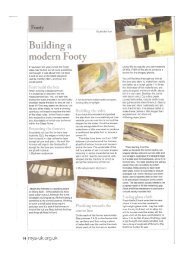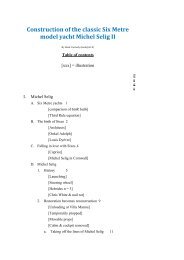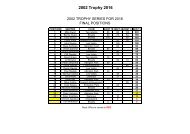Michel Selig II
The Construction of The Classic Six Metre Model Yacht Michel Selig II
The Construction of The Classic Six Metre Model Yacht Michel Selig II
You also want an ePaper? Increase the reach of your titles
YUMPU automatically turns print PDFs into web optimized ePapers that Google loves.
almost exposing the rudder, to lower the waterline length<br />
which compensated the "d" penalty.<br />
Two key opposing concepts in sailboat design are wetted<br />
surface and hull speed In light winds, one wants a<br />
minimum of wetted surface. For stronger winds, when the<br />
boat reaches full speed, it reaches a limit based on its<br />
waterline length (its hull speed). The longer the waterline<br />
length, the faster the hull speed.<br />
Drewitz designed such a light boat that, if the crew moved<br />
forward, the boat tilted forward and its wetted surface was<br />
reduced and, if it moved aft, the boat tilted aft, extending its<br />
waterline length. It was a remarkable concept for the<br />
period. It is now common practice for certain modern<br />
racing yachts.<br />
Apparently, Collignon rejected the concept after the boat<br />
was built. To make her float "normally, he had 120 kg. of<br />
the forward part of the ballast moved aft in the form of forty<br />
3 kg. lead ingots, thereby also rendering her rating so that<br />
she was no longer a Six.<br />
Photo of <strong>Michel</strong> <strong>Selig</strong> before launching. The caption in<br />
German explains Drewitz's concept of shifting the<br />
crew's weight forward and aft, but the boat had<br />
already been "adjusted" by Collignon to give it a







